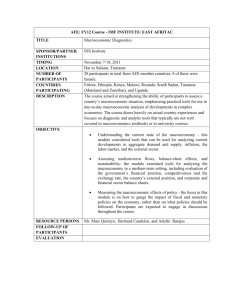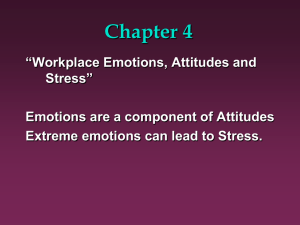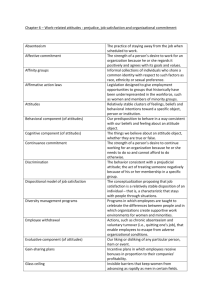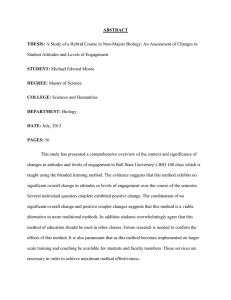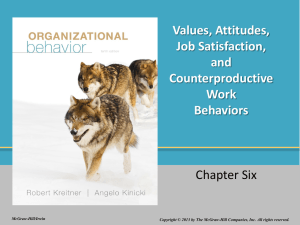Employment Experiences of Older Workers in the Kevin E. Cahill
advertisement
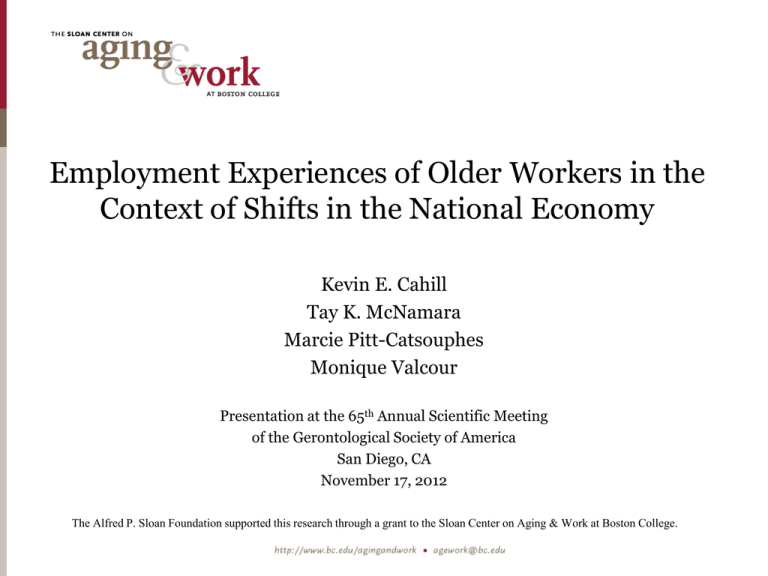
Employment Experiences of Older Workers in the Context of Shifts in the National Economy Kevin E. Cahill Tay K. McNamara Marcie Pitt-Catsouphes Monique Valcour Presentation at the 65th Annual Scientific Meeting of the Gerontological Society of America San Diego, CA November 17, 2012 The Alfred P. Sloan Foundation supported this research through a grant to the Sloan Center on Aging & Work at Boston College. January February March April May June July August September October November December January February March April May June July August September October November December January February March April May June July August September October November December Dow Jones Industrial Average The Timing of the Age & Generations Dataset and the Dow Jones Industrial Average, January 2007 – December 2009 15000 14000 13000 12000 11000 10000 Time 1 2007 Time 2 9000 8000 7000 6000 2008 Date (Year/Month) 2009 The Age & Generations Study Consisted of online and handwritten surveys of employees from nine large organizations (12 worksites) Surveys were conducted at two points in time Time 1 (T1): November 2007 to March 2008 Time 2 (T2): May 2008 to September 2008 A sizable number of employees participated Time 1 (T1): 2,210 (participation rate = 46.4%) Time 2 (T2): 1,360 (participation rate = 28.7%) Approximately 900 employees participated in both surveys Questions focused on employee perceptions Job security, employee engagement, supervisory support, work overload, and job quality Our Paper Research Questions Are employees’ cognitive assessments of and affective and behavioral orientations toward work and the work-life interface related to the economic well-being of the society in which they live? How do the work experiences of older workers compare to those of younger workers? Background The existing literature on the determinants of employee attitudes focuses on family, organization, and societal systems. The role of the broader macroeconomy as a driving force of employee attitudes has largely been unexplored. Description of Macroeconomic Measures and Employee Attitudes Used in Our Paper Mean Scores for Job Satisfaction, Employee Engagement, and Satisfaction with W-F Balance, by Age Group Key Findings: Effects of Macroeconomic Variables on Employee Attitudes +, ++, +++: Indicates a positive coefficient that is significant at the 10%, 5%, and 1% level, respectively. –, – –, – – –: Indicates a negative coefficient that is significant at the 10%, 5%, and 1% level, respectively. Conclusions Across all workers, the state of the macroeconomy is a statisticallysignificant determinant of job satisfaction and satisfaction with workfamily balance. When the macroeconomy performs poorly employees tend to report lower levels of job satisfaction and higher levels of satisfaction with work-family balance. This finding suggests that employees’ job- and family-related attitudes are influenced by factors beyond the immediate job and family domains. An examination of workers by age reveals that those aged 55 years and older report higher engagement scores compared with younger workers, controlling for the current state of the macroeconomy. Older workers’ employment experiences are also less influenced by fluctuations in housing prices compared with younger workers. Implications and Limitations Implications The macroeconomy constitutes an influential context which may shape the effects of managerial decisions and policies on employees’ attitudes toward work and the work-family interface. Limitations The Age & Generations dataset contains at most two points in time per employee and covers the onset of the Great Recession only. The sample of employees is drawn from large employers and, further, from specific departments within these organizations. Changes attributed to macroeconomic conditions could be due to organizational changes that took place in response to the macroeconomy. Outcome measures did not vary widely over time or across employees.
